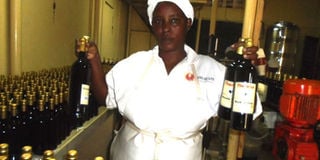Brewing money from hibiscus wine, flowers

A worker shows some bottled hibiscus wine. Photo by Fred Muzaale
What you need to know:
Despite the growing demand for hibiscus wine, Theresa Namusisi brews twice year. She bottles 10,000 litres earning Shs20m as profit, writes Fred Muzaale
Hibiscus also known as Roselle normally grows in the wild. However, a number of farmers are domesticating it in eastern, northern and central parts of Uganda.
The trend is as a result of the discovery of more health benefits, which can be got from the plant.
A number of medicinal products can be got from hibiscus flower such as hibiscus tea, which offer relief to patients with high blood pressure, increases the body’s immune system among the many health benefits.
Hibiscus juice is also taken to increase the blood count in patients with anaemia.
Besides these medicinal products, Theresa Namusisi a vegetable farmer has seen her fortune increase since she started adding value to the crop. She makes hibiscus wine from the flowers of the plant.
A resident of Mbikko village in Njeru Town council, Buikwe District, Namusisi has been making hibiscus flower wine under her company name, LEDO (U) Ltd, since 2004.
The 69-year- old retired nurse says, she took a decision to make hibiscus wine given its high nutritional value and health benefits.
Although she was a nurse, Namusisi had before her retirement got training in wine making as she hoped to carry it out upon retirement.
With about Shs25m savings from her nursing job, Namusisi bought equipment to use in wine making and also constructed a structure to house the factory.
Making hibiscus wine
Lubega Wamala, the Operations Manager, of the company says, they buy dry hibiscus flower from middlemen, who also buy it from farmers in eastern Uganda. They buy a tonne of dry hibiscus flowers at between Shs3m and Shs5m.
A kilogramme goes for between Shs3,000 and Shs5,000, depending on the market forces of demand and supply.
Labour
They employ 25 workers, who carry out work at the various stages of the production process.
Their wine is certified by Uganda National Bureau of Standards and currently they are working on a few things so that they acquire a UNBS quality mark. This, he says would enable them produce for the export market.
Challenges
Their biggest challenge lies in the high value addition and excise duty taxes, which he says cuts into their profits.
Also, he says their “genuine” wine competes with many “fake” wine brands that are on the market.
Hibiscus transforms Njakasi’s life
Like Theresa Namubiru, Timothy Njakasi is another farmer earning from hibiscus. Njakasi is the proprietor of Kasenge River Organic Center in Mbalala village in Nama sub-county, Mukono District. He grows hibiscus from which he harvests flowers.
The flowers, he says, are dried and boiled to extract juice, which he sells at Shs2,000 per half litre.
Additionally, he sells dried hibiscus flowers at Shs1000 for a quarter a kilogramme. Every week, he sells about 200 litres of hibiscus juice and earns about Shs800,000.
He sells his products to drug shops, health centres, retail and wholesale outlets in Mukono and Kampala.
Planting
The steps
•When the flowers are ferried to the factory, they are first sorted to remove the chaff and poor quality.
•The dry flowers are then boiled using firewood to extract juice. The flowers can be boiled several times until a point when no more concentrated red juice gets out of them.
•On the other hand, the sugar mixed with water is also boiled separately to form a liquid.
•Hibiscus flower juice and liquid sugar are mixed together and stirred well after which yeast is added. The yeast aids fermentation.
•The mixture is then put in fermentation or maturation tanks where they are kept for at least six months when the wine matures and is ready to drink.
•When it is mature it is bottled and packed in boxes and sold. Their wine is sold in 750ml bottles, five and 20-litre jerrycans.
Production
Lubega says from 10 kilogrammes of quality hibiscus flowers, they can get 500 litres of wine.
He says since wine takes at least six months to mature, they are into production only twice a year.
“On average, we produce about 5,000 litres of wine each time we go into production,” Lubega says.
He says that they produce four brands of wine namely sweet, medium, and dry and premium wine.
Sweet wine contains a lot of sugar, while medium sweet has average sugar, Premium is sweet but has fruit additives while dry wine is made without adding any sugar.
Market
Lubega says they sell their product in supermarkets and retail shops all over the country.
He says they have a truck they use to transport the wine to supermarkets. However, they also sell to individuals at the factory.




